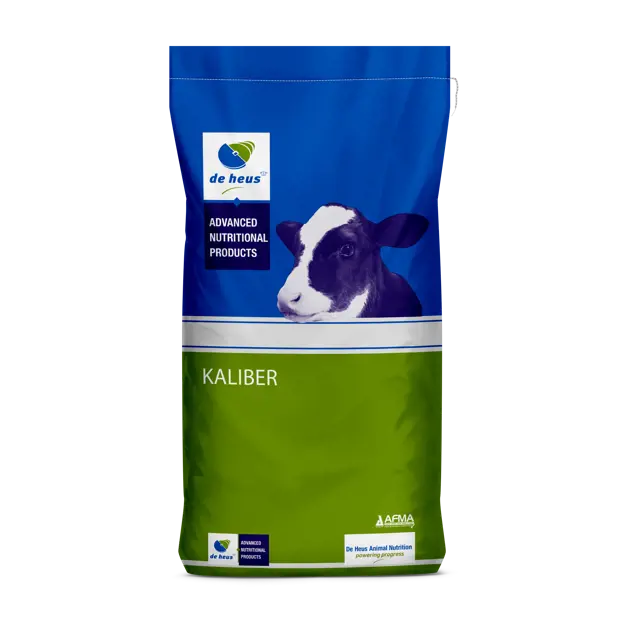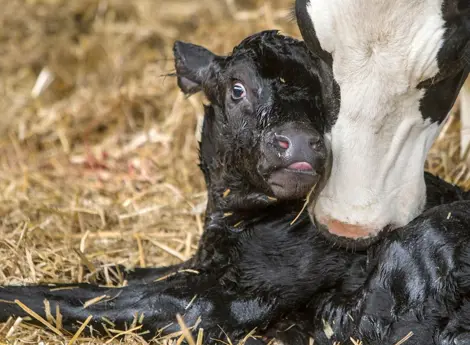
Kaliber
Rearing calves to become heifers
 Kaliber Concept
Kaliber Concept
As a dairy farmer, you work continuously to keep your dairy cows healthy and optimally producing milk. Heifers that enjoy good skeletal development without getting fat have a higher lifetime production. Rear heifers with Kaliber!
Kaliber Concept
The De Heus Kaliber® Calf Rearing Plan is a holistic rearing plan for dairy heifers. De Heus has developed a well-balanced plan, based on years of experience and expertise.
It is designed to rear calves with ‘Kaliber’ in a healthy and economical way. ‘Kaliber’ refers to the animal’s proportions in terms of height, weight and size. This means that the young animal has good skeletal development without getting fat and achieving all this for a 24month old age at first calving.
- The Starting phase 0-5 Months
- The Youth phase 5-8 Months
- The Puberty phase 8-14 Months
- The gestation phase 14-24 Months


Kaliber Calf Rearing Plan
To achieve a heifer with ‘Kaliber’ we distinguish 4 different growth phases:
The Starting phase 0-5 Months
The starting phase is meant to give the calf a solid basis for optimal future development. The goal is to achieve optimal and safe growth during the infant period by using calf milk replacers together with Kaliber® Starter. After weaning, the daily growth must continue to increase. The combination of Kaliber® Starter and excellent quality hay ensures the best development in terms of rumen volume, as well as the rumen wall.
The Youth phase 5-8 Months
The objective of this phase is to utilize maximum growth. Growth in this phase is very efficient when the right ration is provided. It is important to stimulate maximum daily intake and supply growth with specific feed. During this phase, the ration consists of good quality roughage supplemented with Kaliber® Starter and then switching to Kaliber® Junior at 6 months of age.
The Puberty phase 8-14 Months
The puberty phase is crucial in the rearing of heifers. The heifer’s skeleton needs to continue to develop in length and height, without the deposition of fat. Animals with ‘Kaliber’ have visible ribs and a visible backline, as well as dry udder tissue. In this phase, the percentage of compound feed in the final ration is reduced or phased out. Make use of Kaliber® Junior and switch to Kaliber® Senior when appropriate.
The gestation phase 14-24 Months
Heifers are ready for insemination and gestation in this phase. The development objective is continued growth with minimal fat deposition. A well-developed heifer enables the calf to grow properly inside her and to come into the world as a healthy animal. ‘Kaliber’ heifer's calf easily, are active and are able to consume higher amounts of roughage. Make use of Kaliber® Senior products depending on the situation.
The Kaliber® Calf Rearing Plan works! Kaliber® products, top quality roughage and the comprehensive Kaliber® concept result in a heifer with ‘Kaliber’, a calving age of 24 months and a higher lifetime production. For you, this means lower rearing costs and optimal returns. For more information and a detailed feeding program speak to your nearest Technical Advisor today.
Challenges we can help you with
FREQUENTLY ASKED QUESTIONS
We have the answers to your questions
Good colostrum management can help ensure your calf makes a healthy start to life. Providing sufficient high-quality colostrum boosts immunity and reduces the risk of diarrhoea.
Your heifer’s developmental needs are different across each phase of the Kaliber Calf Rearing Plan. For example, solid feed and healthy rumen development are crucial in phase 1, while the priority during phase 2 is maintaining a consistent daily weight gain. These varying requirements require specific nutritional and management practices.
The starter feed intake should be at least 2 kg before you wean your calves and stop giving them milk. Eating too little compound feed after weaning can compromise growth and increase the risk of health problems.
Almost every farm has opportunities to improve how it rears its heifers. This untapped growth potential can be realised by adjusting management practices and applying the right nutritional advice and products. With the right steps, you can develop more productive heifers with a similar cost base.
Are there any challenges we can help you with?







